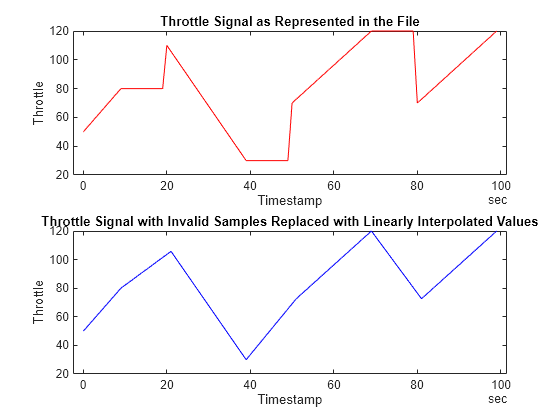从 MDF 文件中读取有效性数据
此示例说明如何从 MDF 文件中读取和使用有效性数据进行预处理。
有效性信息简介
根据 ASAM MDF 标准,“失效位”是一项可选功能,要求每条记录至少有一个额外的字节,用于将记录中的信号值标记为“失效”。这意味着每个通道的每个采样都有自己的失效位。
默认情况下,mdfRead 函数返回有效性数据,该有效性数据与失效位呈现相反的状态。也就是说,如果失效位在文件中标记为 false,指示采样有效,则 mdfRead 为对应的有效性采样返回 true 值。
mdfRead 的 ValidityRule 名称-值参量可控制有效性数据的处理方式:
"
ignore":不读取有效性数据。"
include"(默认值):读取有效性数据并将其存储在时间表的Validity自定义属性中。"
replace":读取有效性数据并用 MATLAB®missing值替换所有无效采样。(注意:整数通道会转换为 double。)
在不使用名称-值参量的情况下读取有效性数据
要从 MDF 文件中读取所有数据,请使用 mdfRead 函数,并仅将文件名作为输入参量。默认情况下,这会读取并包含有效性数据,将其存储在返回的时间表的自定义属性中。每个时间表对应于来自一个特定通道组的数据,并且包括表示该通道组的有效性数据的一个相关时间表。以下 mdfRead 调用等效于指定 ValidityRule='include'。
dataWithValidity = mdfRead("VehicleDataWithInvalidSamples.mf4")Warning: mdfRead returned data that contains invalid samples in channel groups: 1, 2. Get validity data for a channel group from the timetable’s property Properties.CustomProperties.Validity.
dataWithValidity=2×1 cell array
{100×2 timetable}
{100×3 timetable}
chanGrp1Data = dataWithValidity{1}chanGrp1Data=100×2 timetable
time Throttle EngineRPM
______ ________ _________
0 sec 50 0
1 sec 53.333 1
2 sec 56.667 2
3 sec 60 3
4 sec 63.333 4
5 sec 66.667 4
6 sec 70 6
7 sec 73.333 7
8 sec 76.667 8
9 sec 80 9
10 sec 80 9
11 sec 80 9
12 sec 80 9
13 sec 80 9
14 sec 80 9
15 sec 80 9
⋮
mdfRead 调用中抛出的警告指示通道组 1 和 2 中返回的数据都包含无效采样。要检索通道组 1 的有效性数据,请访问时间表的 Validity 自定义属性。请注意,数据时间表和有效性时间表的大小相同。有效性时间表的每个逻辑值对应于数据时间表中对应采样的有效性。
chanGrp1Validity = chanGrp1Data.Properties.CustomProperties.Validity
chanGrp1Validity=100×2 timetable
time Throttle EngineRPM
______ ________ _________
0 sec true true
1 sec true true
2 sec true true
3 sec true true
4 sec true true
5 sec true false
6 sec true true
7 sec true true
8 sec true true
9 sec true true
10 sec false false
11 sec false false
12 sec false false
13 sec false false
14 sec false false
15 sec false false
⋮
有效性数据可用于手动预处理数据时间表。例如,有效性数据可用于删除通道组中包含无效采样的所有行。
validSampleRowsMask = all(chanGrp1Validity{:,:} == 1,2);
dataWithInvalidRowsRemoved = chanGrp1Data(validSampleRowsMask, :)dataWithInvalidRowsRemoved=37×2 timetable
time Throttle EngineRPM
______ ________ _________
0 sec 50 0
1 sec 53.333 1
2 sec 56.667 2
3 sec 60 3
4 sec 63.333 4
6 sec 70 6
7 sec 73.333 7
8 sec 76.667 8
9 sec 80 9
31 sec 63.684 31
32 sec 59.474 32
33 sec 55.263 33
34 sec 51.053 34
35 sec 46.842 35
36 sec 42.632 36
37 sec 38.421 37
⋮
忽略有效性数据
当您的分析不需要有效性数据时,要节省内存和处理时间,请使用参量 ValidityRule="ignore"。
dataValidityIgnored = mdfRead("VehicleDataWithInvalidSamples.mf4", ValidityRule="ignore", GroupNumber=1)
dataValidityIgnored = 1×1 cell array
{100×2 timetable}
请注意,时间表不包含 Validity 自定义属性。
dataValidityIgnored{1}.Propertiesans =
TimetableProperties with properties:
Description: ''
UserData: []
DimensionNames: {'time' 'Variables'}
VariableNames: {'Throttle' 'EngineRPM'}
VariableTypes: ["double" "double"]
VariableDescriptions: {'Throttle' 'EngineRPM'}
VariableUnits: {'*10^2' '*10^2'}
VariableContinuity: []
RowTimes: [100×1 duration]
StartTime: 0 sec
SampleRate: 1
TimeStep: 1 sec
Events: [0×8 eventtable]
CustomProperties: No custom properties are set.
Use addprop and rmprop to modify CustomProperties.
在使用 "replace" 的情况下读取有效性数据
dataInvalidReplaced = mdfRead("VehicleDataWithInvalidSamples.mf4", ValidityRule="replace", GroupNumber=1)
dataInvalidReplaced = 1×1 cell array
{100×2 timetable}
所有无效采样现在都已替换为 missing 值。例如,"EngineRPM" 通道在 t=5 秒处包含无效采样,因此值为 NaN。
dataInvalidReplaced{1}ans=100×2 timetable
time Throttle EngineRPM
______ ________ _________
0 sec 50 0
1 sec 53.333 1
2 sec 56.667 2
3 sec 60 3
4 sec 63.333 4
5 sec 66.667 NaN
6 sec 70 6
7 sec 73.333 7
8 sec 76.667 8
9 sec 80 9
10 sec NaN NaN
11 sec NaN NaN
12 sec NaN NaN
13 sec NaN NaN
14 sec NaN NaN
15 sec NaN NaN
⋮
预处理数据
MATLAB 提供多种处理时间表中缺失值的函数,例如 fillmissing。当填充方法设置为 'linear' 时,此函数通过对相邻的非缺失值(有效采样)进行线性插值为无效采样设置新值。
dataPreprocessed = fillmissing(dataInvalidReplaced{1}, 'linear')dataPreprocessed=100×2 timetable
time Throttle EngineRPM
______ ________ _________
0 sec 50 0
1 sec 53.333 1
2 sec 56.667 2
3 sec 60 3
4 sec 63.333 4
5 sec 66.667 5
6 sec 70 6
7 sec 73.333 7
8 sec 76.667 8
9 sec 80 9
10 sec 82.149 10
11 sec 84.298 11
12 sec 86.447 12
13 sec 88.596 13
14 sec 90.746 14
15 sec 92.895 15
⋮
有关预处理数据的详细信息,请参阅数据预处理。
Throttle 通道的直观比较
针对原始数据(存在于文件中)和使用无效采样的新值已进行线性插值的数据,绘制 "Throttle" 通道对时间通道的图。
subplot(2, 1, 1) plot(chanGrp1Data.time, chanGrp1Data.Throttle, "r") title("Throttle Signal as Represented in the File", "FontWeight", "bold") xlabel("Timestamp") ylabel("Throttle") subplot(2, 1, 2) plot(dataPreprocessed.time, dataPreprocessed.Throttle, "b") title("Throttle Signal with Invalid Samples Replaced with Linearly Interpolated Values", "FontWeight", "bold") xlabel("Timestamp") ylabel("Throttle")

结论
根据您的需要使用 ValidityRule 选项:
当有效性数据与您的分析无关时,请使用 "
ignore" 以节省内存和处理时间。当要手动处理无效采样时,请使用 "
include"。当使用 "
fillmissing" 或rmmissing等函数处理无效采样时,为方便起见,请使用replace。